BIG OLD STICKS
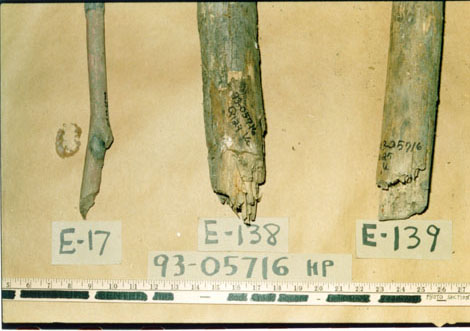
Sticks gathered from the crime scene.
Inspector Gary Gitchell: Did you ever use, did anyone use a stick and hit the boys with?
Jessie Misskelley: Damien had kind of a big old stick when he hit that first one, after he hit him with his fist and knocked him down and then he got him a big old stick and hit him.
Gitchell: What did the stick look like, I mean was it like a, a, a big log like that or is it, is it a stick?
Misskelley: It, I would say it was about that, about that big around, I would say about that long.
Gitchell: Okay
Detective Bryn Ridge: About the size of a baseball bat, maybe just a little bit bigger around?
Misskelley: Mm-hmm. That's about right. [Misskelley confession, June 3, 1993]
Big Old Sticks
Upon Detective Gitchell's prompting, Misskelley said a stick had been used to hit one of the children. Misskelley went on to state a stick was used to choke Chris Byers to death.
Ridge: Okay, which one did you see killed?
Misskelley: That one right there.
Gitchell: Now, you're pointing to the Byers boy again?
Misskelley: Mm-hmm.
Ridge: How was he actually killed?
Misskelley: He did, he choked him real bad like.
Ridge: Choked him? Okay, what was he choking him with?
Misskelley: His hands, like a, like a stick, he had a big old stick, and he's kind of holding it over his neck. [ibid]
Each of the victims received a number of blunt trauma injuries consistent with being struck by a heavy object. The wounds did not, however, contain any wood fragments or splinters.
Defense attorney Paul Ford: Ok. But you would expect to find those - some sort of wood fragment left behind?
Medical Examiner Dr. Frank Peretti: I think I would expect to find some fragments.
Ford: Did you?
Peretti: No. [Echols/Baldwin trial]
The prosecution presented the sticks as potential weapons. The defense went on to quiz Peretti as to a long list of items that could have caused the contusions.
- a 2 x 4 piece of wood
- a baseball bat - (noted it would have a different but similar pattern)
- a rolling pin
- the flat part of shovel
- a broom handle
- a mop handle
- the shovel handle
- a jack handle
- a flashlight
- a tire iron
- hundreds of items (general statement)
- hundreds of items located in almost any household
There was also no evidence that any of the victims had been choked.
Defense attorney Dan Stidham: Dr. Peretti, if you were told that one of the victims was choked, specifically the victim Byers was choked with a big old stick, would you expect to find some evidence, some abrasions, bruising, a line of demarcation, something indicating choking?
Peretti: I would expect to find a pattern or injury on the neck and the underlying neck muscles.
Stidham: Did you find any such patterns?
Peretti: No.
Stidham: Did you find any such patterns on the victim, Byers, specifically?
Peretti: No.
Stidham: Was there any abrasions or injury to the strap muscles of the neck?
Peretti: No.
Stidham: Were there any fractures of the larynx or the...how do you say that?
Peretti: Hyoid bone. No.
Stidham: Would you expect to find those had a victim been choked?
Peretti: Well, you may not find fractures of the hyoid bone because in young children it's very difficult to fracture it but I would expect to find hemorrhage.
Stidham: So does it appear be any--does there appear to be any evidence of sodomy or choking on any of these victims?
Peretti: Um, no. [Misskelley trial]
Before Misskelley's confession several objects that could have caused blunt trauma were collected by the police. From the crime scene:
- E-17, a long thin branch found floating in the water.
- E-41, a claw hammer.
From suspect Richard Cummings:
- E-25, tire billy.
- E-29, E-30, E-31 three hammers.
Shortly after Misskelley's confession, several more items were gathered from the crime scene including E-132, wooden slats. Then one month later, Ridge returned to the crime scene and retrieved two large sticks, E-138 and E-139.
On July 1, 1993, I went to the crime scene to determine if any evidence could be found that had been overlooked during the initial searches of the area of the above noted homicide. I discovered that there were two sticks at the crime scene that had gone previously undetected. [Report, Detective Bryn Ridge]
In contrast to "previously undetected," at the trial Detective Ridge described E-139 as being the stick that was used to jam the children's clothing into the mud. Even though it was by definition an item handled by the perpetrator, it was not collected as evidence until two months after the murders.
Ridge: [Referring to a photo] This is the crime scene - this is the area here where the body of Michael Moore was located, this is the stick E-139 that had the shirt wrapped around the end of it that was jabbed into the mud.
Fogleman: Is that exhibit 55 for identification purposes?
Ridge: If that's the exhibit number, I'm not certain. Exhibit 38 is a photograph of me as I'm removing this shirt from the end of that stick of E-139. [Echols/Baldwin trial]
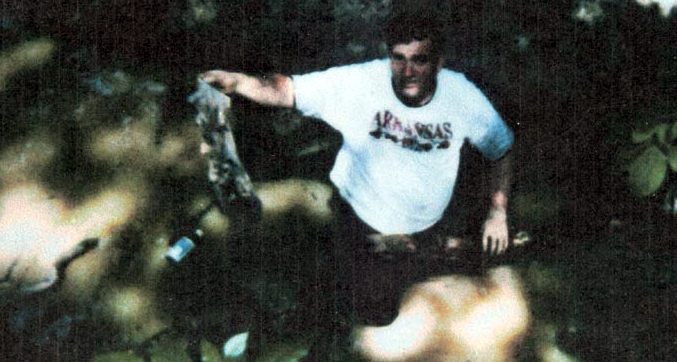
Exhibit 38, Detective Ridge holding up a shirt. Ridge identified the stick in his left hand as E-139.
The defense objected to the introduction of the sticks that were gathered in July.
Defense attorney Val Price: Judge, at this time we'd object to this stick. This stick is E number E-139 which was not recovered by Detective Ridge at the crime scene - this was a stick that Mr. Ridge found at the crime scene two months after the murders on July 1, 1993 and we object to this stick as being of relevance for any purpose. [Echols/Baldwin trial]
This objection led to a voir dire with the defense contesting the relevancy of the evidence.
Price: Ok. Well, on - isn't it true that on July the 1st 1993, you went back to the crime scene and found E-139 - that stick?
Ridge: Yes sir, that's correct.
Price: Ok. So that stick was not the stick that was at the crime scene?
Ridge: Yes sir, it is the stick that was at the crime scene.
Price: Alright, so - I guess I'm confused. At the time, you did not take that stick into evidence - at the time that y'all recovered the bodies?
Ridge: No sir. I didn't take this stick into evidence until the statement of Jessie Misskelley in which he said a stick -
Price: Your Honor! Move for a mistrial. Your Honor! [ibid]
In the Echols/Baldwin trial, Misskelley's confession could not be referenced. Since Misskelley was unwilling to testify to support the confession, the defendants would be denied their right to face their accuser. The event that initiated the mistrial hearing was odd - the stick being referenced was cited as being used to hold down the clothes and by itself this had nothing to do with the Misskelley confession. Furthermore, the gross oversight in not collecting it as evidence, one of the few items that had been certainly handled by the murderer, was never explained.
The mistrial hearing took place out of the hearing of the jury. It was brief and dramatic. The arguments reflected what was asked and said. Judge Burnett lead the argument against a mistrial with the prosecution barely getting a word in. Between the time when it was made certain the jury could not hear until Burnett formally declared, "Denied" there were 42 statements. The defense made twenty of these, Burnett made sixteen, and Fogleman made six. Of those six, three were to ask that the testimony be played back and one was to ask permission to speak. Burnett phrased the precipitating exchange as:
Burnett: You [Price] said, "I'm confused on that, you mean you didn't take the stick on - on the day that you were first there" - I'm paraphrasing. And then you said, "Did you go back later?" and he [Ridge] said "Yes sir, I went back after Jessie Misskelley's statement." [Burnett, Echols/Baldwin trial]
Burnett went on to say Price's question asked for why he went back and the answer was appropriate to the form of the question. "He basically asked him, "Well, why did you go back?" and he was proceeding to tell him why." [Burnett, ibid]
The defense said that there was nothing in the question that required Ridge's response and asked repeatedly that the actual testimony be played back for consideration. In an odd twist, the prosecution also asked repeatedly that the tape be played back. Burnett refused: "I heard it. I know what he said and in my opinion, it's not - it's not error in the first place." [Burnett, ibid]
Two matters were of importance. First, whether an error was made when Ridge responded in such a manner, and second whether what happened merited a mistrial. Burnett said there was not an error (quoted above). Secondly, he ruled against a mistrial because (1) no error was made, (2) the jury (and everyone) knew of the existence of the confessions and (3) Ridge's comment was on its existence not its content. Furthermore, Burnett stated that a mistrial was a harsh remedy. Burnett denied the mistrial and denied a severance of trials.
Burnett mischaracterized the question and answer. There was no "why" being asked. It was a yes or no question. The comment made by Ridge did include the content of Misskelley's confession, the fact that Misskelley had mentioned a stick, giving an important validation to this piece of wood. Burnett overruled even the prosecution's wishes that the statements be played back.
Defense attorney Davidson: I don't think he said that, Your Honor. We would like to ask the tape be played back and see what it says.
Fogleman: Well, let's play it back.
Davidson: Ok.
Fogleman: Let's play it back.
Davidson: That's what we say.
...
Fogleman: Your Honor, the state submits that - and maybe it might be good to play back the question and what the answer was. [Echols/Baldwin trial]
Later, after the motion for mistrial was denied, the defense aggressively attacked Ridge for his delay in retrieving the sticks - this time without incident.
Davidson: And you left that at the scene, is that correct?
Ridge: That's correct.
Davidson: Did a lightbulb ever go off in your heading thinking when you pulled that out that there may be some evidential value in that stick - and you just left it out there? Anything ever go through your mind like that?
Ridge: Not on that day it didn't, no sir. [ibid]
The defense ridiculed the recovery of the sticks again in their closing arguments.
Paul Ford: Then, Officer Ridge hits the jackpot. "I'll go back in July and find the murder weapon!" Take this stick. It's evidence. Take this stick, it just crumbles. The bark just crumbles. Was there any of this -- was there any of this on any of the injuries? Dr. Peretti said no. It just crumbles. Is there any blood on it, any hair on it, anything on it? Yet they want you to believe that’s it. That’s what they want you to believe. The witnesses won’t tell you that, but these prosecutors want you to believe that’s it. Why else would it be here? Two months after the crime when this murder weapon appears. [ibid]
Val Price: The State had said, particularly the stick that was used to push some of the clothing down in the water. Part of that stick was up above the water. And the testimony was, yes when things are in water, it's hard to get prints off of 'em, but if objects, you know, it's possible to get fingerprints off objects that aren't in water. When the police went to the crime scene and found that particular stick that was wrapped around the clothing, what do they do with that stick? They left it at the crime scene. And it wasn't until, not one, but two months later, that Detective Ridge went back out there and found that stick and I think found another one. [ibid]
No tissue, blood or fingerprints were found on the sticks. The prosecution did put on a witness to say there was evidence that one of the sticks had been handled. Ralph Turbyfill was the Chief Latent Fingerprints Examiner with the Arkansas State Crime Laboratory.
Fogleman: Alright. I want to show you what's been introduced as State's Exhibit 53. Do you recognize that? [Exhibit 53 had been previously identified as E-17]
Turbyfill: Yes, I do.
Fogleman: Alright. And did you also examine that item?
Turbyfill: I examined this item, this item was uh, processed using a chemical called ninhydrin. N-I-N-H-Y-D-R-I-N, which is an amino acid indicator. On paper, cardboard, and unpainted wood, that chemical is used and it turns the fingerprints a light purple or violet, you can -- there are indications that amino acids are present on this, however, there are no latent fingerprints of value for identification.
......
Fogleman: Alright. Alright. Ok. And what - I'm a little confused - what is the purpose of the thing about the amino acids?
Turbyfill: The body has amino acids in it and one of the chemicals that we use reacts or colors that particular amino acid. And this pink reaction is the result of the coloring of that amino acid. Which uh - fingerprints has that amino acid and on paper, unpainted wood, and cardboard we can detect fingerprints using that chemical. So - I mean that, just because there's reaction, that doesn't mean it was handled or that it was a fingerprint.
Fogleman: Ok. So it could mean that it was handled or it could be from something in the water?
Turbyfill: That's correct. It's possibly because it was handled.
Amino acids are one of the basic building blocks of all life, including bacterial, algae, plant and animal. Although it is possible that this stick was handled (Ridge does not appear to be wearing gloves while holding E-139 in the above photo), it is also possible this was a non-specific reaction. It was certain that the stick used to hold down the clothes had been handled, but this showed no reaction.
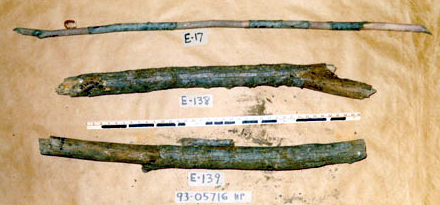
The three sticks.
|


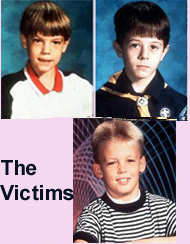
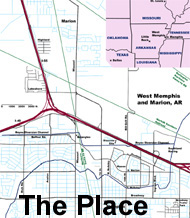
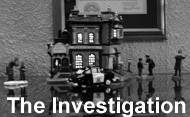

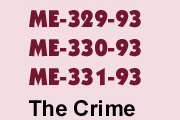
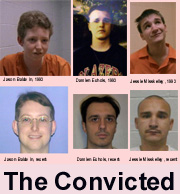
![]()
![]()